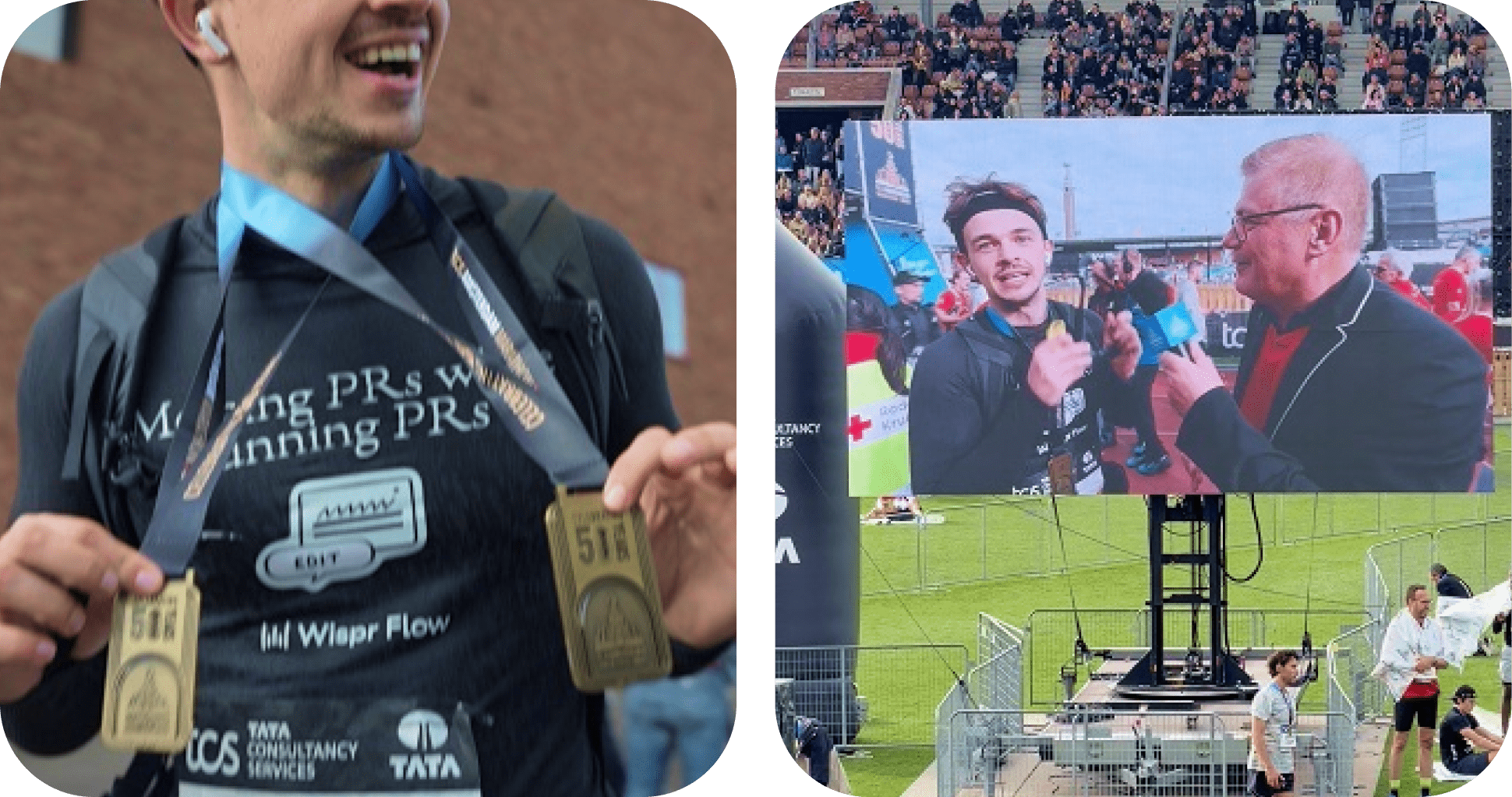
When building moves beyond the desk
At the starting line of the Amsterdam Marathon, Tijs Nieuwboer looked a little out of place. He had a MacBook strapped to his back, a cable running from his backpack to a pair of AR glasses, and a single Nintendo Switch controller in his right hand.
Tijs is a founder and self-taught developer from the Netherlands. Over the past year, he’d been vibe coding in Cursor, using Wispr Flow to write code with his voice. After a weekend-long coding binge where he pressed the voice button “for almost 48 hours straight,” he realized he didn’t really need a keyboard at all.
Then came an idea only he could dream up: if coding no longer required a desk, why not prove it mid-stride? So he reached out to us with his plan. He came up with the plan. We just helped him tell the story.
Preparing Flow for the ultimate test
Less than one percent of people have ever run a marathon. None had ever built a working app while running one. This meant that he had to invent his own custom setup to make it possible.
1. Seeing his laptop while running
To get a laptop screen in front of his eyes, he started testing different AR glasses, most of which bounced so much while running that the text became unreadable.
One pair literally shook with every step. Another washed out in sunlight. The glasses he planned to use broke right before race week, forcing a last-minute buy of a newer model with built-in stabilization. That last-second swap turned out to be a blessing in disguise, because that pair was the best one yet.
2. Controlling his laptop with one hand
For control, he needed something that he could use to operate his laptop while moving, but no good devices existed. So he had to come up with his own.
He then discovered a software called Enjoyable, which lets you connect a game controller to your laptop and map buttons however you like.
First, he tried a PlayStation controller he had lying around, until he realized it required two hands. Then, he realized he could try a Switch controller! Tiny, light, and fit in one hand.
3. Getting everything to work together
In practice, getting everything to talk to each other was chaos. Some test runs ended with cables popping loose, screens disconnecting, or the controller refusing to pair. He’d cycle between “this might actually work” and “why am I doing this to myself?” on a near-daily basis.
The final setup
By the time race day arrived, his setup looked something like this:
- A MacBook in a backpack, with cables snaking out the top
- AR glasses connected by a long wire, stabilized with a headband so they wouldn’t ricochet with every step
- A Switch controller acting as a cursor, zoom tool, and emergency fallback when voice commands got breathless
- Wispr Flow handling all voice input, even when he was panting into the wind
It wasn’t sleek. It wasn’t polished. But it worked just well enough to give Tijs hope that this stunt was possible.
Race day: 42 kilometers of code

Amsterdam buzzed with thousands of runners at the starting line. Within the first kilometer, Tijs lost his laptop connection, but he didn’t stop. He opened his backpack mid-stride, wires spilling out, reconnected, and kept moving.
People would stop and ask if he was working, so he'd respond to say “We couldn’t take time off work, but we also wanted to run the marathon!”
For a few kilometers, everything clicked. His voice flowed into code, variables registered, files tagged. He was literally speaking an app into existence while running through Amsterdam. Then came the setbacks: fogged glasses, shaky breath, too many commands at once. He restarted the project twice before finally getting it to work around kilometer 18.
Between coding and running, he was also directing a camera crew that kept missing meeting spots.
By kilometer 26, only a fraction of the app’s features worked, but he pushed on anyway, determined to finish both race and build.
The app that kept him moving

The result was Hypes, a voice-based companion designed to keep you accountable to your goals. It listens, reflects, and talks back when your motivation dips.
“It was exactly what I needed in that moment,” Tijs says. “A voice that keeps you moving.”The concept was simple but personal: turn conversation into encouragement. While most runners rely on music or pacing apps, Hypes uses dialogue to keep you going, a reminder that talking to technology can be more human than tapping it.
Tijs wanted to hack his own run and create software around what he was experiencing: pushing people to commit to their goals and see them through. Not with generic motivation, but with a voice that knows your goal and keeps you moving when you want to stop.
During the race, he entered his goal into the app: finish the marathon while building it. Around kilometer 35, the voice loop finally responded to his goal in real time. That was the moment he knew he had proven that you can build something meaningful, even in motion.
The idea resonated far beyond the marathon. As soon as he finished the race, Tijs was interviewed on national TV in the Netherlands about his run, his app, and how he’d managed to code while racing.
Proving what’s possible when coding is hands-free
Tijs’s marathon wasn’t really about running or even about coding. It was about proving that anyone can build something if they have an idea and the determination to see it through.
AI has already made it easier to turn ideas into real things. With voice tools like Wispr Flow, creation becomes even more natural. You can speak your thoughts and see them take shape on screen, without ever touching a keyboard.
That means building is no longer limited to people with technical skills. Anyone can do it.“Everyone has their own marathon,” Tijs says. “Mine just happened to be a literal one. ”Whether you’re starting a company, writing a book, or building an app, the hardest part is pushing through the moment when you want to stop. Hypes was made to help people through that point, to keep going when it gets tough.
At Wispr, we believe creation should feel effortless. Tijs’s run showed what happens when that becomes true.
“If I can build something with my voice while running a marathon,” Tijs says, “what’s stopping you from building yours from your couch?”

Start flowing
Effortless voice dictation in every application: for teams working across tabs, tools, and time zones.


